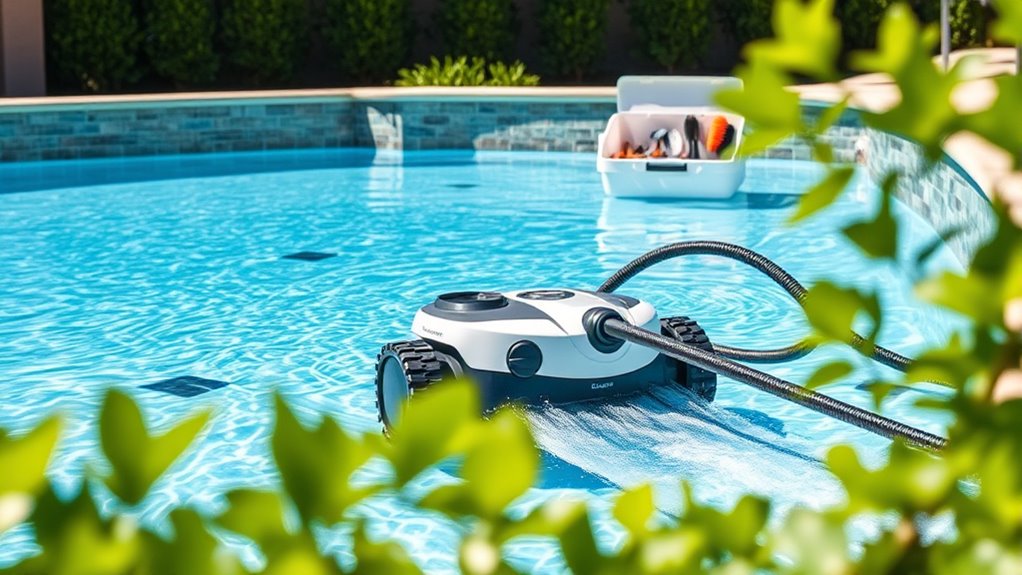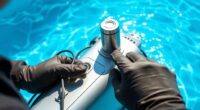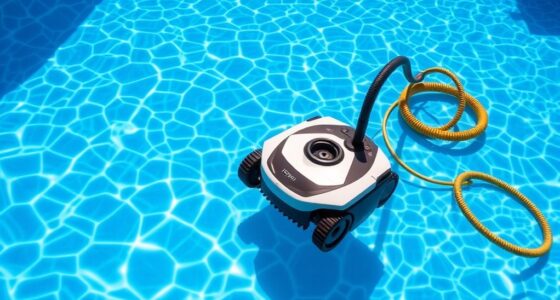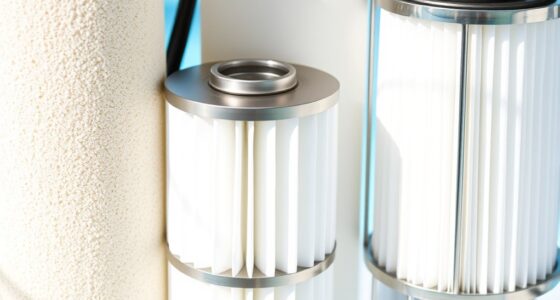To maintain your pressure pool cleaner, regularly inspect and clean the filter bag, removing debris and checking for damage. Clear any obstructions from nozzles and jets, and examine hoses for leaks or cracks. Keep water pressure balanced, and clean the skimmer and pump baskets frequently. Lubricate moving parts, store the cleaner properly during off-season, and replace worn components promptly. For detailed tips, explore the full maintenance guide to keep your cleaner running smoothly.
Key Takeaways
- Regularly inspect and clean the filter bag, nozzles, hoses, and baskets to prevent clogs and ensure optimal performance.
- Maintain proper water chemistry by testing and adjusting pH, chlorine, and alkalinity weekly for clean water.
- Lubricate moving parts like wheels and brushes with silicone-based lubricant at recommended intervals.
- Store the cleaner in a dry, cool area during off-season, draining water from hoses and components to prevent damage.
- Schedule professional maintenance for calibration, inspection, and timely component replacement to extend lifespan.
Inspect and Clean the Filter Bag Regularly

How often should you check the filter bag on your pressure pool cleaner? You should inspect it regularly, at least once a week during heavy use, to guarantee peak performance. During filter bag inspection, look for debris, leaves, and dirt that can clog the bag and reduce cleaning efficiency. If the filter bag appears full or dirty, it’s time for filter cleaning. A clean filter bag allows your pressure pool cleaner to operate smoothly and maintain proper suction. Don’t wait until the bag is overflowing; frequent filter cleaning prevents strain on the cleaner’s motor and prolongs its lifespan. Regularly monitoring indoor air quality and cleaning the filter bag can help identify when additional maintenance or filter replacement is necessary. Additionally, checking the filter bag material for wear or damage ensures optimal filtration and performance. Ensuring your filter system maintains proper airflow is essential for effective cleaning and energy efficiency. Keep a routine of checking and cleaning the filter bag to ensure your pool stays clean and your pressure cleaner runs effectively.
Check and Clear the Nozzles and Jets
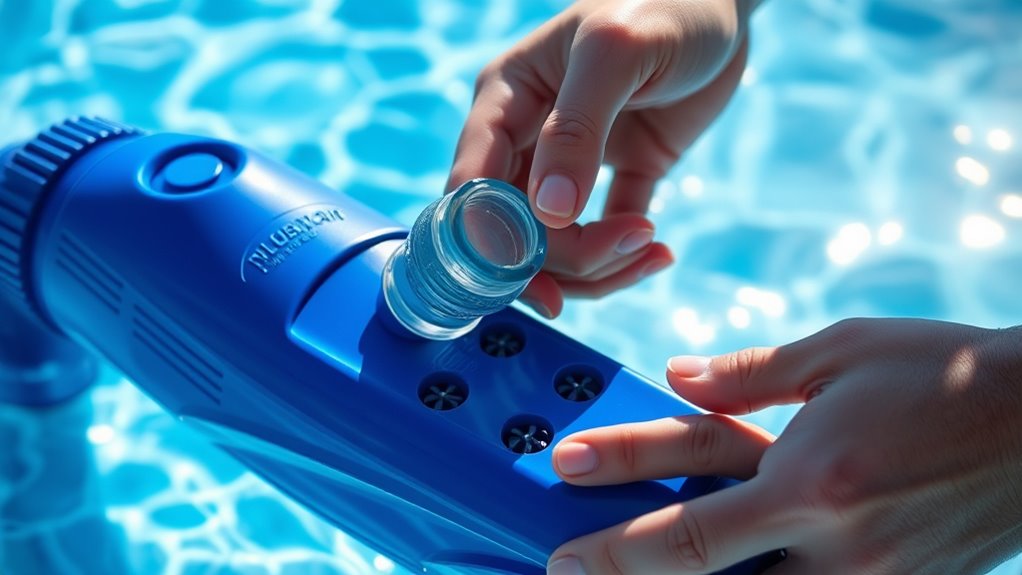
To guarantee your pressure pool cleaner operates efficiently, you should regularly check and clear the nozzles and jets for obstructions. Start by inspecting each nozzle and jet for debris or buildup that can hinder water flow. Proper nozzle calibration and jet alignment are essential for ideal cleaning performance. If you notice uneven spray patterns or reduced pressure, adjust the jet alignment accordingly. Clear any blockages with a small brush or pin, ensuring no debris remains. Regular maintenance prevents clogs that can decrease efficiency or cause damage. Remember these key points:
Regularly inspect and clear nozzles and jets to maintain optimal pressure pool cleaner performance.
- Check for debris in nozzles and jets
- Clear obstructions promptly
- Adjust jet alignment for even spray
- Ensure nozzle calibration is correct
- Use a small tool to remove stubborn blockages
- Regular inspection of components helps prevent pressure drops and prolongs the cleaner’s lifespan. Additionally, using high-quality nozzles can improve water flow and overall cleaning efficiency. Properly maintaining the nozzles and jets also reduces the need for costly repairs. Incorporating tuning techniques from vehicle maintenance can extend the lifespan and performance of your pool cleaner. Regularly inspecting water flow components ensures optimal operation and can help identify potential issues early. Consistent checks keep your cleaner running smoothly.
Examine the Hoses for Damage or Leaks

After checking and clearing the nozzles and jets, it’s important to examine the hoses for any signs of damage or leaks. Hose inspection helps you identify cracks, holes, or worn areas that could hinder your cleaner’s performance. Look closely for any leaks or drips along the length of the hoses, especially near connections. Leak detection is vital because even small leaks can reduce water pressure, impairing cleaning efficiency. Gently squeeze the hoses to check for soft spots or weak areas. If you find any damage or leaks, replace or repair the hoses promptly to maintain ideal pressure and prevent further issues. Regular hose inspection ensures your pressure pool cleaner functions smoothly and extends its lifespan. Incorporating protective styling benefits from textile techniques can also help maintain the durability of your hoses over time. Additionally, understanding the divorce process in your state can be crucial if legal issues arise related to property or shared assets. Staying informed about automation in business can inspire new ways to optimize maintenance routines and tools used in pool care.
Furthermore, consulting professional repair services can be beneficial if you’re unsure about performing repairs yourself or if the damage is extensive.
Ensure Proper Water Pressure and Flow
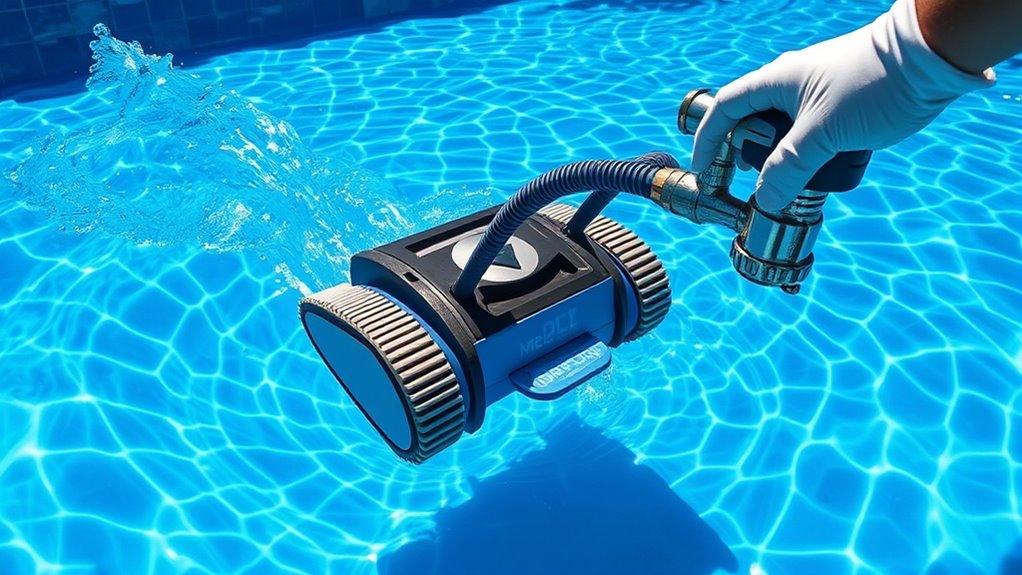
Ensuring proper water pressure and flow is essential for your pressure pool cleaner to operate effectively. If the water flow or pump pressure is too low, the cleaner won’t move properly; if too high, it could damage parts. Regularly check your pump pressure and adjust it according to the manufacturer’s guidelines. To maintain peak performance:
Proper water pressure and flow are vital for your pool cleaner’s optimal performance and longevity.
- Keep hoses free of obstructions
- Adjust the pump pressure to recommended levels
- Check for leaks in connections
- Ensure the skimmer and pump baskets are clean
- Avoid blockages in the return jets
- Monitor filter performance regularly to prevent clogs that reduce water flow. Additionally, understanding performance tuning principles can help you optimize your pump settings for better efficiency and longevity. Proper water flow also helps prevent clog buildup, ensuring your cleaner runs smoothly and efficiently. Maintaining correct refrigeration cycle parameters in your pool system can further enhance overall performance and energy efficiency. Proper water flow and pressure regulation help your cleaner function smoothly, reduce wear, and prolong its lifespan. Proper water flow ensures thorough cleaning, saving you time and effort.
Clean the Skimmer and Pump Basket
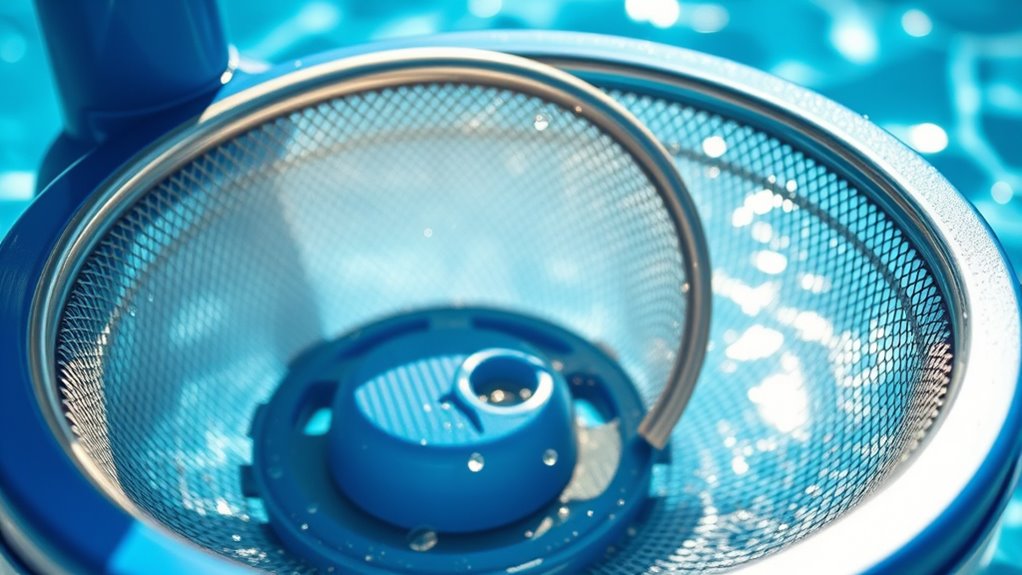
Have you checked your skimmer and pump baskets lately? Regular skimmer maintenance and pump basket cleaning are essential to keep your pressure pool cleaner working efficiently. When debris accumulates, water flow slows, reducing cleaning power. Remove the baskets, empty them, and rinse thoroughly with a hose. This prevents clogging and ensures proper circulation. Use the table below as a quick guide:
| Step | Action |
|---|---|
| Remove baskets | Take out the skimmer and pump baskets |
| Empty debris | Dispose of leaves and dirt |
| Rinse and inspect | Wash with water and check for damage |
Keeping these components clean helps your pool cleaner perform at its best and extends its lifespan. Regular maintenance is also important for understanding grocery savings strategies and ensuring your equipment functions optimally for pool care.
Maintain the Pool’s Water Chemistry
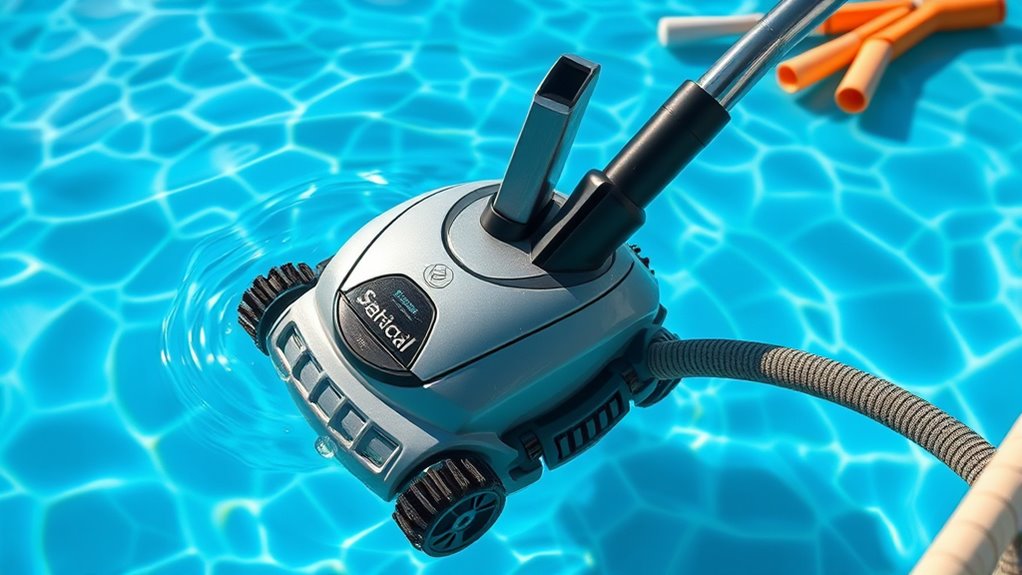
Are you regularly checking and balancing your pool’s water chemistry? Maintaining proper chemical balance ensures your pressure pool cleaner works efficiently and extends its lifespan. Focus on keeping pH levels between 7.2 and 7.6, as imbalances can cause scaling or corrosion. Test your water weekly and adjust chemicals accordingly. Here are key tips to maintain water chemistry:
Regularly test and balance your pool water to keep your pressure cleaner running smoothly.
- Regularly test pH, chlorine, alkalinity, and stabilizer levels
- Keep pH within the recommended range for ideal performance
- Add pH increasers or decreasers as needed
- Use chlorine or other sanitizers to maintain clean water
- Shock the pool periodically to eliminate contaminants
Balancing your water’s chemical levels prevents buildup, protects your equipment, and keeps your pool cleaner longer. Proper chemical management is essential for the smooth operation of your pressure pool cleaner.
Lubricate Moving Parts as Needed

Lubricating the moving parts of your pressure pool cleaner is essential to keep it operating smoothly and prevent unnecessary wear. Regular lubrication at specific lubrication points ensures moving part maintenance remains effective. Focus on parts like the wheels, brushes, and the swiveling head, applying a silicone-based lubricant suitable for plastic and rubber components. Avoid over-lubricating, which can attract dirt and debris, causing more harm than good. Check your cleaner’s manual for recommended lubrication intervals and types of lubricants. Proper lubrication reduces friction, minimizes strain on motor components, and extends the cleaner’s lifespan. Incorporate this routine into your maintenance schedule to keep your pressure pool cleaner functioning efficiently and avoid costly repairs caused by neglected moving part maintenance.
Store the Cleaner Properly During Off-Season

Before storing your pressure pool cleaner, make sure to clean it thoroughly to prevent damage. Keep it in a dry area, away from moisture and humidity. Also, protect it from freezing temperatures to avoid cracking or other issues during the off-season.
Clean Before Storage
Have you ever wondered why proper cleaning before storage extends your pressure pool cleaner’s lifespan? It’s essential to guarantee the cleaner is free of debris, dirt, and chemicals that could cause damage during off-season storage. Before storing, thoroughly rinse the entire unit with fresh water to remove residue. Check the chemical balance in your pool to prevent corrosion or mold growth on the cleaner. Proper cleaning promotes pool safety, preventing mold or bacteria buildup. Additionally, consider these tips:
- Remove and clean filters
- Inspect hoses for cracks
- Drain water from all parts
- Lubricate moving components
- Store in a cool, dry place
This routine helps maintain your cleaner’s functionality and longevity, ensuring it’s ready to go when pool season returns.
Store in Dry Area
To keep your pressure pool cleaner in top condition during the off-season, storing it in a dry, sheltered area is essential. Indoor storage prevents exposure to moisture and harsh weather that can cause damage. When choosing a location, consider temperature factors; avoid areas with extreme heat or cold, which can affect seals and electronic parts. A consistent, moderate temperature helps prolong your cleaner’s lifespan. Use the table below to compare storage options:
| Location | Moisture Control | Temperature Stability |
|---|---|---|
| Garage | Good | Variable |
| Basement | Excellent | Stable |
| Outdoor Shed | Poor | Unpredictable |
Proper storage guarantees your pressure pool cleaner stays functional and ready for next season.
Protect From Freezing
Storing your pressure pool cleaner properly during the off-season helps prevent damage caused by freezing temperatures. Freezing can crack hoses, damage internal parts, and ruin your equipment. To protect your cleaner, follow winterization tips that focus on temperature regulation. Before storing, thoroughly rinse and dry the unit to prevent mold and corrosion. Store it in a dry, sheltered area away from freezing conditions. Consider these tips:
- Drain all water from hoses and components
- Use compressor or air to blow out remaining water
- Store in a temperature-controlled environment
- Cover with a protective tarp or cover
- Disconnect power and store in a safe, accessible spot
These steps ensure your pressure pool cleaner stays in good shape during the off-season, ready for next year’s pool season.
Replace Worn or Broken Components Promptly

You should regularly check your pressure pool cleaner for signs of wear or damage, like cracks or leaks. Replacing these parts promptly prevents further damage and keeps your cleaner working efficiently. Acting quickly saves you time and money in the long run.
Detecting Wear and Damage
Regularly inspecting your pressure pool cleaner for signs of wear and damage is essential to keep it functioning efficiently. Look for cracks, tears, or broken parts, especially on the hoses and brushes. Keep an eye on debris accumulation, which can indicate blockages or worn components affecting performance. Check the cleaner’s wheels and swivels for smooth operation, and listen for unusual noises during use.
Be vigilant for:
- Cracked or broken hoses
- Worn or frayed brushes
- Excess debris buildup
- Difficulties moving or turning
- Visible damage to joints or fittings
Promptly replacing worn or broken components prevents further damage and maintains effective cleaning. Regular inspections ensure your cleaner continues to protect your pool surface and handle debris efficiently.
Prompt Replacement Benefits
Promptly replacing worn or broken components helps prevent further damage and guarantees your pressure pool cleaner continues to operate effectively. This proactive approach enhances energy efficiency, reducing power consumption and lowering your bills. Additionally, the replacement benefits include extending your cleaner’s lifespan, avoiding costly repairs, and maintaining peak cleaning performance. Delaying replacements can lead to more severe damage and inefficient operation.
| Component | Replacement Benefit | Impact on Energy Efficiency |
|---|---|---|
| Brushes | Improved scrubbing action | Higher efficiency |
| Hoses | Prevent leaks and clogs | Lower energy use |
| Jets | Better water flow | Reduced power consumption |
| Drive belts | Smoother operation | Less energy waste |
| Filter components | Enhanced debris removal | Maintains efficiency |
Schedule Periodic Professional Maintenance

Scheduling periodic professional maintenance guarantees your pressure pool cleaner operates at peak efficiency and extends its lifespan. Regular check-ups guarantee that all components work together smoothly, promoting pool safety and ideal equipment compatibility. A professional can spot potential issues early, preventing costly repairs and downtime. During maintenance, they’ll clean filters, inspect hoses, and verify proper operation, ensuring your cleaner performs reliably.
Remember these key points:
- Guarantee proper calibration for ideal cleaning
- Check for wear and tear on hoses and fittings
- Verify electrical connections for safety
- Confirm compatibility with your pool’s equipment
- Maintain clean filters to improve efficiency
Frequently Asked Questions
How Often Should I Perform Maintenance on My Pressure Pool Cleaner?
You should perform maintenance on your pressure pool cleaner regularly, following a consistent maintenance schedule. Typically, cleaning frequency depends on pool usage and debris levels, but aim to check it at least once a week. Inspect hoses and brushes for wear, clean filters, and remove debris to keep it running efficiently. Regular upkeep prevents breakdowns and extends your cleaner’s lifespan, ensuring your pool stays clean and inviting all season long.
Can I Use Any Cleaning Chemicals on the Cleaner’S Parts?
You should be cautious about using cleaning chemicals on your pressure pool cleaner’s parts. Not all chemicals are compatible, so check the manufacturer’s guidelines for chemical compatibility. Using harsh or incompatible cleaners can damage components over time. Regular cleaning frequency helps prevent buildup and extends the cleaner’s life. Stick to recommended cleaning products and routine maintenance to keep your pressure pool cleaner functioning efficiently and avoid costly repairs.
What Are Signs My Pool Cleaner Needs Professional Repairs?
If your pool cleaner leaks or makes unusual noises, it’s time to call a professional. Leaks often indicate worn-out seals or damaged hoses, while strange sounds could mean motor issues or blockages. Don’t ignore these signs, as they can worsen over time. A professional can diagnose and fix the problem promptly, ensuring your pressure pool cleaner works efficiently and prolongs its lifespan.
How Do I Troubleshoot if the Cleaner Isn’t Moving Properly?
If your pool cleaner isn’t moving properly, start troubleshooting by checking for pool hose issues like blockages or leaks, which can prevent proper movement. Inspect the cleaner’s motor for signs of malfunction, such as unusual noises or failure to start. Make sure the hose connections are secure and free of obstructions. If these steps don’t resolve the problem, consider testing the motor or replacing worn-out parts to get your cleaner working smoothly again.
Is It Necessary to Replace the Entire Cleaner or Just Parts?
Did you know that over 60% of pool cleaner issues are fixed with parts replacement or component repair? When your pressure pool cleaner isn’t working properly, you don’t always need to replace the entire unit. Usually, replacing a malfunctioning hose, nozzle, or motor component is enough to get it running smoothly again. This approach saves you money and extends your cleaner’s lifespan, making repairs simple and cost-effective.
Conclusion
By following these simple steps, you’ll turn your pool cleaner into an unstoppable underwater superhero! Regular maintenance keeps it running smoother than a dolphin gliding through crystal-clear waters, and prevents it from turning into a rusty, broken-down mess. With a little love and attention, your pressure pool cleaner will be your loyal aquatic sidekick, battling dirt and debris like a hero every time you plunge in. Keep it in top shape, and your pool will stay pristine forever!

